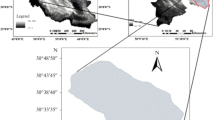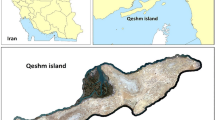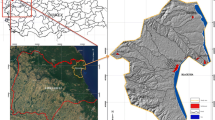Abstract
The purpose of this study was to use current and historic land use/land cover (LULC) changes to predict future LULC using coupled Cellular Automata–Markov chain model. Landsat time series data for the month of June were used to determine LULC changes for the years 1984, 1995, 2005 and 2015 using random forest classification system in R. We then used Markov Chain algorithm with multiple perceptron in land change modeler to simulate future LULC dynamics for the years 2025, 2035 and 2045. Contingent valuation method was employed to estimate ecological value of wetlands. Results for the LULC analysis for the period between 1984 and 2015 show a decline in woodland and wetland area owing to natural and human factors. We noted a reduced net change for grassland, woodland and mountain vegetation covers losing by − 4%, − 5.2%, − 2% and − 4% change, respectively. While, riverine vegetation, crop field and rock outcrop gained by 0.5%, 4% and 10.2%, respectively. A notable dramatic decline in wetland area was recorded between 1995 and 2005 losing about 125.53 ha, which could be attributed to recurrent droughts of 1995, 1998, 2002 and 2005. Major conversions were from wetland cover to crop fields suggesting agricultural encroachment onto the wetland area. Wetland area, thus, significantly decreased by 6% (p < 0.05) amounting to 236.52 ha in the last 30 years. Coupled CA–Markov chain model results for the years 2025, 2035 and 2045 predicted a further increase in cropfield at the expense of woodland and wetland area. In particular, wetland area is expected to further shrink by 46% (72.67) by the year 2045. Contingent valuation results show that every respondent concurs that wetlands have deteriorated to a very bad state in comparison to their state in the twentieth century. The cited reduced wetland health, biodiversity of both flora and fauna, water quality and quantity and general wetland area. The present state is estimated to be far less than 10% of the total value of wetlands 20 years ago. Quantifying such future wetland area changes is important not only for pure-scientific purposes but also for appropriately developing locally relevant and sustainable management strategies for wetland conservation.














Similar content being viewed by others
References
Adam E, Mutanga O, Abdel-Rahman EM, Ismail R (2014) Estimating standing biomass in papyrus (Cyperus papyrus L.) swamp: exploratory of in situ hyperspectral indices and random forest regression. Int J Remote Sens 35:693–714. https://doi.org/10.1080/01431161.2013.870676
Ashton PJ, Love D, Mahachi H, Dirks P (2001) An overview of the impact of mining and mineral processing operations on water resources and water quality in the Zambezi, Limpopo and Olifants Catchments in Southern Africa. Contract Rep. Min. Miner. Sustain. Dev. South. Afr. Proj. CSIR-Environ. Pretoria Geol. Dep. Univ. Zimb.-Harare Rep. No ENV-PC 42
Breiman L (2001) Random forests. Mach Learn 45:5–32
Breiman L (1996) Bagging predictors. Mach Learn 24:123–140
Burkett V, Kusler J (2000) Climate change: potential impacts and interactions in wetlands of the United States 1. Wiley Online Library
Change IC (2013) The Physical Science Basis. Working group I contribution to the fifth assessment report of the intergovernmental panel on climate change. Camb. UK, NY, USA
Congalton R (1991) A review of assessing accuracy of classification of remote sensing data. Remote Sens Environ 37:35–46
Ellery W, Grenfell S, Grenfell M, Powell R, Kotze D, Marren P, Knight J (2016) Wetlands in southern Africa: a geomorphic threshold perspective. Quaternary environmental change in southern Africa: physical and human dimensions. Cambridge University Press, UK, pp 188–202
Erwin KL (2009) Wetlands and global climate change: the role of wetland restoration in a changing world. Wetl Ecol Manag 17:71–84. https://doi.org/10.1007/s11273-008-9119-1
Feng L, Han X, Hu C, Chen X (2016) Four decades of wetland changes of the largest freshwater lake in China: possible linkage to the three Gorges Dam? Remote Sens Environ 176:43–55. https://doi.org/10.1016/j.rse.2016.01.011
Feng L, Hu C, Chen X, Cai X, Tian L, Gan W (2012) Assessment of inundation changes of Poyang Lake using MODIS observations between 2000 and 2010. Remote Sens Environ 121:80–92. https://doi.org/10.1016/j.rse.2012.01.014
Finlayson CM (2016) Climate Change and Wetlands. In: Finlayson CM, Everard M, Irvine K, McInnes RJ, Middleton BA, van Dam AA, Davidson NC (eds) The wetland book: I: structure and function, management and methods. Springer, The Netherlands, pp 1–12
Grimm R, Behrens T, Märker M, Elsenbeer H (2008) Soil organic carbon concentrations and stocks on Barro Colorado Island—digital soil mapping using random forests analysis. Geoderma 146:102–113. https://doi.org/10.1016/j.geoderma.2008.05.008
Hagen A (2002) Multi-method assessment of map similarity. In: Proceedings of the Fifth AGILE Conference on Geographic Information Science, Palma, Spain. Association of Geographic Information Laboratories Europe, pp. 171–182
Han X, Chen X, Feng L (2015) Four decades of winter wetland changes in Poyang Lake based on Landsat observations between 1973 and 2013. Remote Sens Environ 156:426–437. https://doi.org/10.1016/j.rse.2014.10.003
Ibarrola-Rivas MJ, Granados-Ramírez R, Nonhebel S (2017) Is the available cropland and water enough for food demand? A global perspective of the land-water-food Nexus. Adv Water Resour 110:476–483. https://doi.org/10.1016/j.advwatres.2017.09.018
Jhonnerie R, Siregar VP, Nababan B, Prasetyo LB, Wouthuyzen S (2015) Mangrove coverage change detection using Landsat imageries based on hybrid classification in Kembung River, Bengkalis Island, and Riau province. J. Ilmu Dan Teknol. Kelaut. Trop. 6
Jogo W, Hassan R (2010) Balancing the use of wetlands for economic well-being and ecological security: the case of the Limpopo wetland in southern Africa. Ecol Econ 69:1569–1579. https://doi.org/10.1016/j.ecolecon.2010.02.021
Junk WJ, An S, Finlayson CM, Gopal B, Květ J, Mitchell SA, Mitsch WJ, Robarts RD (2013) Current state of knowledge regarding the world’s wetlands and their future under global climate change: a synthesis. Aquat Sci 75:151–167. https://doi.org/10.1007/s00027-012-0278-z
Kabii T (1996) An overview of African wetlands
Khawaldah AH (2016) A prediction of future land use/land cover in Amman area using GIS-based Markov Model and remote sensing. J Geogr Inform Syst 8:412–427
Lee H, Yuan T, Jung HC, Beighley E (2015) Mapping wetland water depths over the central Congo Basin using PALSAR ScanSAR, Envisat altimetry, and MODIS VCF data. Remote Sens Environ 159:70–79. https://doi.org/10.1016/j.rse.2014.11.030
Madebwe V, Madebwe C (2005) An exploratory analysis of the social, economic and environmental impacts on wetlands: The Case of Shurugwi District, Midlands Province Zimbabwe. J Appl Sci Res 1:228–233
Marambanyika T, Beckedahl H, Ngetar NS, Dube T (2016) Assessing the environmental sustainability of cultivation systems in wetlands using the WET-Health framework in Zimbabwe. Phys Geogr 1–21:62–82. https://doi.org/10.1080/02723646.2016.1251751
Mitsch WJ, Gosselink JG (2000) The value of wetlands: importance of scale and landscape setting. Ecol Econ 35:25–33
Mugandani R, Wuta M, Makarau A, Chipindu B (2012) Re-classification of agro-ecological regions of Zimbabwe in conformity with climate variability and change. Afr Crop Sci J 20:361–369
Mushowe TD, Odindi J, Dube T, Mutanga O (2017) Prediction of future urban surface temperatures using medium resolution data in Harare metropolitan city, Zimbabwe. Build Environ 122:397–410
Mwita E, Menz G, Misana S, Becker M, Kisanga D, Boehme B (2013) Mapping small wetlands of Kenya and Tanzania using remote sensing techniques. Int J Appl Earth Obs Geoinformation 21:173–183. https://doi.org/10.1016/j.jag.2012.08.010
Liu N, Wang H (2010) Ensemble based extreme learning machine. IEEE Signal Process Lett 17:754–757. https://doi.org/10.1109/LSP.2010.2053356
Ricaurte LF, Olaya-Rodríguez MH, Cepeda-Valencia J, Lara D, Arroyave-Suárez J, Max Finlayson C, Palomo I (2017) Future impacts of drivers of change on wetland ecosystem services in Colombia. Glob Environ Change 44:158–169. https://doi.org/10.1016/j.gloenvcha.2017.04.001
Rodríguez JF, Saco PM, Sandi S, Saintilan N, Riccardi G (2017) Potential increase in coastal wetland vulnerability to sea-level rise suggested by considering hydrodynamic attenuation effects. Nat Commun 8:16094. https://doi.org/10.1038/ncomms16094
Sang L, Zhang C, Yang J, Zhu D, Yun W (2011) Simulation of land use spatial pattern of towns and villages based on CA–Markov model. Math Comput Model 54:938–943. https://doi.org/10.1016/j.mcm.2010.11.019
Sango I, Godwell N (2015) Climate change trends and environmental impacts in the Makonde Communal Lands, Zimbabwe. South Afr J Sci 111:1–6
Scharsich V, Mtata K, Hauhs M, Lange H, Bogner C (2017) Analysing land cover and land use change in the Matobo National Park and surroundings in Zimbabwe. Remote Sens Environ 194:278–286. https://doi.org/10.1016/j.rse.2017.03.037
Schuijt K (2002) Land and water use of wetlands in Africa: economic values of African wetlands
Sibanda S, Grab SW, Ahmed F (2017) Spatio-temporal temperature trends and extreme hydro-climatic events in southern Zimbabwe. South Afr Geogr J 1–23:210–232. https://doi.org/10.1080/03736245.2017.1397541
Sithole A, Murewi CT (2009) Climate variability and change over southern Africa: impacts and challenges. Afr J Ecol 47:17–20
Subedi P, Subedi K, Thapa B (2013) Application of a hybrid cellular automaton–Markov (CA–Markov) model in land-use change prediction: a case study of Saddle Creek Drainage Basin Florida. Appl Ecol Environ Sci 1:126–132. https://doi.org/10.12691/aees-1-6-5
Verhoeven J, Arheimer B, Yin C, Hefting M (2006) Regional and global concerns over wetlands and water quality. Trends Ecol Evol 21:96–103. https://doi.org/10.1016/j.tree.2005.11.015
Wagner PD, Kumar S, Schneider K (2013) An assessment of land use change impacts on the water resources of the Mula and Mutha Rivers catchment upstream of Pune, India. Hydrol Earth Syst Sci 17:2233–2246. https://doi.org/10.5194/hess-17-2233-2013
Wetland International (2009) n.d. Wetland International Annual Review
Yang X, Zheng X-Q, Chen R (2014) A land use change model: integrating landscape pattern indexes and Markov-CA. Ecol Model 283:1–7. https://doi.org/10.1016/j.ecolmodel.2014.03.011
ZIMSTAT Z (2016) Zimbabwe Demographic and Health Survey 2015: Final Report
Author information
Authors and Affiliations
Corresponding author
Additional information
Publisher's Note
Springer Nature remains neutral with regard to jurisdictional claims in published maps and institutional affiliations.
Rights and permissions
About this article
Cite this article
Sibanda, S., Ahmed, F. Modelling historic and future land use/land cover changes and their impact on wetland area in Shashe sub-catchment, Zimbabwe. Model. Earth Syst. Environ. 7, 57–70 (2021). https://doi.org/10.1007/s40808-020-00963-y
Received:
Accepted:
Published:
Issue Date:
DOI: https://doi.org/10.1007/s40808-020-00963-y




